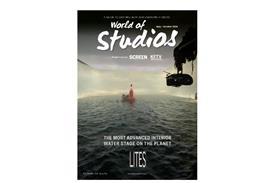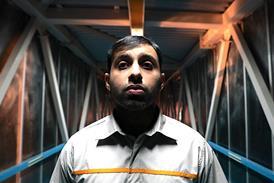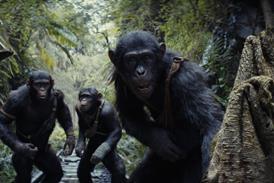With established film infrastructures and fascinating landscapes, Serbia and Croatia have been quietly luring productions away from the nearby centres of Prague and Budapest. Now both are introducing valuable tax incentives to give international producers two competitive new location hubs.
Ralph Fiennes said he was drawn to the Serbian capital Belgrade by its blend of neo-classical and contemporary architecture. The actor-director shot his visceral take on Shakespeare’s Coriolanus in the city in 2009. “Belgrade also has something bruised about it, which is appropriate for this story,” says Fiennes in reference to the Balkan war of the early 1990s.
However, practically speaking, those days of conflict are gone. The city today is a beguiling mix of elegant 19th-century facades, imposing Tito-era tenement blocks and sleek steel-and-concrete offices and malls.
Shooting costs are an estimated 20% lower than those of its neighbouring countries and around 40% below those of western Europe.
The new Serbia Film Incentive, an initiative of the Serbian Film Commission, is a straightforward 15% cash rebate on goods, products and services purchased by international productions spending at least $2.9m (¤2m) in the country. It offers a further 12% rebate on Serbian labour, which also includes foreign crew and talent if paid in Serbia during the production.
Producers have to apply via a Serbian production company or a special-purpose vehicle. There is no cultural test. The budget for 2011 is $2.2m (€1.5m), which sounds low but is unlikely to run out this year as the rebate will only be open to applications from the autumn.
Serbia’s growing popularity as a location means a fairly sophisticated film infrastructure is already in place. PFI Studios outside Belgrade has hosted recent projects including FilmNation and Relativity Media’s historical murder mystery The Raven and EuropaCorp’s sci-fi title Lockout. The studio has eight fully equipped sound stages with multistorey production annexes housing fully serviced production facilities, as well as a 12.5 hectare backlot. It also holds a 1,200 sq m green stage.
Belgrade also has a number of alternative studio spaces. Post-production facilities include a new film laboratory, advanced sound mixing and orchestration facilities, and VFX design studios. While many productions head to Belgrade for its urban backdrop, the country boasts richly varied landscapes including a desert.
Visiting productions tend to need only to bring in key technicians. The country’s non-union crews, mostly English speaking, are held in high regard, particularly the art departments. However, at the moment crews struggle to accommodate more than one or two big projects at a time.
“The skill base is rather small and can be restricting,” says US art director Frank Walsh, who worked on The Raven and Lockout in Serbia. “But as more films are made there, experience and skilled crew numbers should increase.”
Case study: The Raven
Both Serbia and Hungary stood in for 19th-century Baltimore in James McTeigue’s fantastical take on the last days of US writer Edgar Allan Poe as he hunts down a serial killer. John Cusack stars in the film, which is produced by Intrepid Pictures, FilmNation Entertainment and Galavis Film. FilmNation is handing sales and Relativity is releasing in the US. The nine-week shoot earlier this year went first to neighbouring Hungary for two-and-a-half weeks including two days on Mafilm’s Fot stages as well as Budapest’s streets and exteriors. It then moved to Serbia for a week, shooting on location in Novi Sad, about an hour from Belgrade, and Kulpin, before heading to Belgrade for locations and stage work. The production shot for three weeks at PFI Studios just outside the city and at the Fox television studios.
Why did you choose to shoot in Serbia?
Marc D Evans, producer, Intrepid Pictures: We wanted to replicate 1849 Baltimore, which is difficult to do not only in Baltimore itself, but in many US cities too. Serbia had a number of locations that provided production design elements that we were seeking. Serbia also offered lower production costs and hard-working crews. And we were very impressed with the production services available through Work in Progress.
Where else did you consider?
Aaron Ryder, producer, FilmNation: Budapest was our first choice, where we shot a third of the film. We also considered New Orleans but it was cost-prohibitive.
ME: We ended up shooting two weeks in Budapest, which offered us a few practical locations that we weren’t able to replicate elsewhere.
What were your cost savings?
ME: We saved $3m-$5m, depending on where you compare to.
AR: They were big enough that it made sense for us to get familiar with all the restaurants in Belgrade.
Did you bring crew in or use local crews?
ME: Many of our heads of department were brought in from the UK, and a couple from Germany, Italy and Hungary. Another movie was shooting in Serbia at the time, so the number of local heads was limited. However, the majority of our crew — grip, electric, construction, set dressing, some of the camera department, transportation, locations — were local. They were some of the hardest-working crews we’ve worked with, and they turned out very high quality work for us.
Which local person or company was most useful?
ME: The Work in Progress team was invaluable in helping us put together the movie and navigate the Serbian film landscape. Pink [PFI] and Fox studios also provided good stage space for us to build a number of our sets and house production offices.
What advice would you give other producers?
ME: I highly recommend meeting with Angie Vlaisavljevic at WIP. While the Serbian crews are excellent to work with, the infrastructure to support multiple major productions is limited at the moment so it will be necessary to bring in certain department heads from elsewhere to round out the crew.
AR: Stay away from Serbia. I want it for my productions!
Would you shoot in Serbia again?
ME: Absolutely. Serbia and the surrounding areas offer a tremendous variety of landscapes, cityscapes, stages, and period and contemporary locations, and the crews are eager and enthusiastic to welcome US and European films. There is a rich history of film-making in the area and the people warmly embrace foreigners and their projects.
AR: I’m in pre-production on our next film, which will shoot in Serbia this autumn.
Case study: Coriolanus
Ralph Fiennes’ directorial debut, a contemporary take on Shakespeare’s play, shot for two months in spring 2010 entirely on location in Serbia. It was produced by Julia Taylor-Stanley of Artemis Films, Gabrielle Tana of Magnolia Mae Films and Colin Vaines of London-based Synchronistic. Backing came from Icon Entertainment International when Bill Pohlad’s River Road Entertainment pulled out. It screened in competition at the Berlinale earlier this year.
Why did you choose to shoot in Serbia?
Gabrielle Tana: Ralph scouted and considered most of the Balkan and eastern European countries. For this film, Belgrade and Serbia resonated more profoundly than other places. In response, the country stepped up to facilitate. We had exceptional support from government and the military which enhanced our production value. It was clear the country wanted to participate and help to make a film with artistic integrity and talent.
Colin Vaines: Because of her local connections, Gabrielle Tana was able to access funding from Serbia, as well as having connections which enabled us to film in the Serbian parliament building, to use military vehicles and to have military police provided for use as soldiers in the movie.
What were your cost savings?
CV: Our line producer, Kevan Van Thompson, points out that any budget prior to him going to Serbia and working with the on-site production people there was nearly $3m higher.
Did you bring in all your crew or use local crews?
CV: We brought in some key British crew — Barry Ackroyd, our cinematographer, and Ricky Eyres, our production designer, among them. But much of the crew was local.
GT: Local keys included costume [Bojana Nikitovic], assistant director [Zoran Andric] and line producer [Angie Vlaisavljevic]. Good talent on the ground is learning and has great potential for future productions.
Which local person or company was the most useful?
CV: We worked very closely with Angie Vlaisavljevic of Work in Progress. She was superb in working with us to make the film for the agreed budget.
Location, location, location
For a relatively small country, Croatia offers an intriguing range of locations — continental, Mediterranean and mountainous climates. Within a 200km radius, it is possible to film three different seasons and landscapes. Croatia’s 1,200 islands and Adriatic coast have made tourism the country’s largest industry, so the infrastructure is top-notch, with impressive hotels.
In the last decade, Croatia has served as the backdrop to films such as Emily Young’s Kiss Of Life, Richard Shepard’s The Hunting Party and Dominic Murphy’s White Lightnin’. The latest is Peter Greenaway’s Goltzius And The Pelican Company, now in production. Set in the late-1500s, the production has recreated a castle on the Rhine at locations in and around Zagreb.
Croatia’s new 20% tax rebate for international film and TV productions was unveiled in May and will become active in December.
The cash rebate applies to feature, documentary and short films, as well as TV drama and animation. It is worth up to 20% of the qualifying expenditure, including the cost of local cast and crew working in Croatia and goods and services bought there, up to 80% of the overall budget spent in Croatia. The qualifying expenditure has a ceiling set at $4.4m (€3m) per project, and the minimum local spend is $440,000 (€300,000).
Foreign producers must team up with a Croatian co-producer who then applies to HAVC, the country’s film and television body, for a provisional certificate before shooting starts, and for a final certificate on completion of the production in the country. The local co-producer provides and takes full responsibility for all services including location scouting, scheduling, budgeting, casting and crewing throughout the production in Croatia.
In order to qualify, a project has to pass a cultural test which consists of three categories: cultural content, creative talents and production. The net benefit will be paid after the completion of production, audit of the final cost statement and evidence that all requirements have been met.
International producers say visiting shoots can rely on the Croatian film infrastructure and crews, as well as state-of-the-art post-production facilities. Zagreb’s Jadran Film is a technically advanced studio, though not comparable in size or capability with Prague’s Barrandov Studios. The crews are skilled, experienced and fluent in English, and Croatia can accommodate up to three big productions at a time.
The capital, Zagreb, is evocative of Vienna and Budapest, with architecture ranging from Roman to impressive examples of post-Second World War design.
Case study: White Lightnin’
Croatia stood in for West Virginia when Dominic Murphy’s fictional account of the real-life dancer and violent career criminal Jesco White shot in the country for six weeks in 2008. It was produced by Mike Downey and Sam Taylor of the UK’s Film & Music Entertainment (F&ME), who have filmed in Croatia for the past decade on both their own titles and as co-producers of local projects such as Goran Rusinovic’s Buick Riviera. F&ME is now shooting Peter Greenaway’s Goltzius And The Pelican Company in and around Zagreb.
Why did you shoot in Croatia?
Mike Downey: Because of the enormous talent pool, the reliability of the production partners, the creativity on all levels, both in the department heads and the production crews. There’s a real can-do attitude.
Where else did you consider?
MD: We were choosing between North Carolina and Croatia. We couldn’t be comfortable with shooting in the US because we felt vulnerable to the unions and to a feeling the sands of a deal were always moving. In Croatia we have a sense of security, that the job will get done, not just based on contracts and money but on a code of personal honour and pride in doing the best possible job.
What were your cost savings?
MD: The difference between being able to make the film or not. So, huge.
Did you bring crew in or use local crews?
MD: On White Lightnin’, we used all local apart from the DoP. We brought one sound mixer to the sound crew as we were shooting in English.
Which local person or company was the most useful?
MD: I would recommend three production companies: Igor Nola’s Mainframe, Boris T Matic’s Propeler Film and Ankica Juric Tilic’s Kinorama.
What advice would you give other producers?
MD: Do not waste any of your time by bringing in loads of department heads and crew from home. Go in and make the most of the local talent pool. It’s all there, you just need to find the best people and the right balance by getting to know people and being frank about your requirements. Also, be humble.
Would you shoot in Croatia again?
MD: Absolutely — if the project was right and the prices were normal and the incentives are there. Having shot on every continent, I would have no hesitation in shooting in Croatia again.






















No comments yet